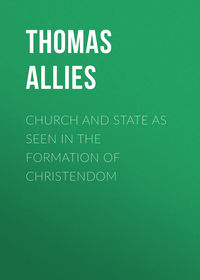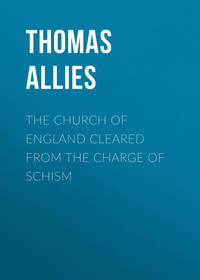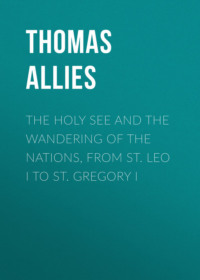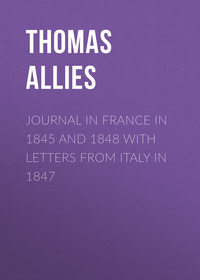 полная версия
полная версияPeter's Rock in Mohammed's Flood, from St. Gregory the Great to St. Leo III
The Sixth Council closes a crisis of danger to the faith of the Church than which no greater is to be found in all history. The years from 638, in which Honorius died, to 682, in which his successor St. Leo II. approved the doctrinal decision of the Council, and further, allowed the conduct of a predecessor to be condemned, are occupied by ten successors of Honorius, every one of whom with the utmost zeal condemned the heresy which was supported by two emperors, wielding absolute power, and by four successive patriarchs of Constantinople, besides patriarchs of Alexandria and Antioch. All these put ecclesiastical authority at the service of these emperors to carry out their will. Heraclius and Constans II. were not theologians, and it required theological skill to construct concerning the Person of our Lord a heresy which could present itself to the fastidious Greek mind, clothed in proper expressions of a language lending itself with unsurpassable accuracy to every variation of thought. Cyrus, made for his first suggestions, by the grateful monarch, patriarch of Alexandria, was so good as to provide Heraclius with doctrinal decrees intended to make the disloyal sects of Egypt believe that they could express their own false doctrine in words which might pass for an assent to the Council of Chalcedon and the doctrine of St. Leo. When the patriarch Sophronius denounced the error and appealed to Rome and Pope Honorius in words which after twelve hundred years sound like a trumpet's call, Sergius being patriarch of Constantinople, the bosom friend and most trusted counsellor of Heraclius, holding the see of the Golden City for eight and twenty years, living and dying, too, in the greatest renown as an orthodox bishop, approached Pope Honorius with insidious language, totally disguising the real state of things in the East. He wished the Pope to believe that Cyrus of Alexandria was winning the proud and tumultuous sects of Egypt to Catholic union with the doctrine of St. Leo, which Honorius held with the utmost fidelity. Not only did he write letters, but he constructed a document to which he induced the emperor to set the imperial seal and require it to be signed by all bishops, and especially by the bishop of Rome. The document was intended to introduce that heresy formulated by Cyrus, which Sophronius exposed and refuted. Pope Honorius died in October 638, and never saw this document. Sergius got it passed by his Council at Constantinople, but died himself in December of the same year. Pope Severinus was elected to succeed Honorius before the end of the year 638, but his consecration was delayed by Greek intrigues for nineteen months, in the hope of obtaining his assent to the document drawn up by Sergius. This was found to be hopeless. The exarch then contented himself with plundering the Lateran treasury. Pope Severinus was at length consecrated, and sat for two months and six days, in which time however he condemned the Ecthesis. He was succeeded by two Popes, John IV. and Theodore, who behaved with the same decision and fortitude. But a new emperor had succeeded, after a frightful revolution, at twelve years of age; and a new patriarch of Constantinople was ready to draw up a new document for the heresy. It was met by another Pope, whose first act was to call a great Council at the Lateran, to condemn the heresy under anathema, and the two documents, of which the first was fathered by Heraclius, and the second by Constans II. For this act of courage St. Martin four years afterwards was stolen from Rome, judged at Constantinople as a traitor by the senate, and sent a prisoner to die of famine, as is believed, in the Crimea. The emperor, having Rome in full possession, used such means that Eugenius was put into the see while St. Martin was still living as a condemned criminal. But Eugenius could not be compelled to accept the heresy of the Byzantine monarch and patriarch. There follow five Popes, Vitalian, Adeodatus, Donus, Agatho, and Leo II. At length, when Constans had perished miserably in his bath at Syracuse, his son Constantine broke the line of heretical emperors. But he found in truth the heresy so embedded in his capital that he was obliged to act with great caution. After repulsing a Mohammedan attack upon his capital which lasted seven years, and was overcome only by the aid of the Greek fire, when if the city had been taken the Greek empire would have ended, and the patriarch of Constantinople have shared the lot of his brethren at Alexandria and Antioch, the emperor was enabled to invite Pope Donus to hold a Council at Constantinople which should terminate this long struggle. It was a struggle in which the whole West followed the Pope, but much of the East was in favour of the heresy. Pope Agatho had succeeded Donus; he accepted the request of the emperor, he had Councils held through the West, and a full patriarchal Council at Rome. So he appeared by his legates at Constantinople, and was welcomed with the words, “Peter has spoken by Agatho,” as 230 years before they cried, “Peter has spoken by Leo”. But Agatho also died before the Council had finished its work, and the tenth successor of Honorius, Leo II., during his short pontificate of ten months, set his seal upon the Council, and endured to censure a predecessor for neglect of his office, and for allowing by that neglect a heresy to obtain a temporary success. Ten Popes in succession, one of them actually martyred, all of them vassals of absolute sovereigns, had during all this interval of forty years alone prevented the heresy being forced upon the Church. Four patriarchs of Constantinople in succession had fostered it; and four were together condemned. They were condemned, not for negligence in allowing others to spread the heresy, but as its originators; as advisers and mouthpiece of emperors, all whose power had been bent by them to extort approval of it from Popes, who in their civil position were helpless subjects in a “servile” province, but in their religious character were successors of St. Peter.
Now at the time the western emperor ceased to exist seven Popes succeeding St. Leo defended his doctrine against two emperors, Zeno and Anastasius, and foiled all the efforts of Acacius to use the eastern jealousy and the pride of the royal city, and exalt his see above the control of St. Peter's successor, until the seventh Pope, Hormisdas, then a subject of the Arian Gothic king, Theodorich, compelled the eastern emperor, the patriarch, the bishops, and the court, to confess his supreme authority, as successor of St. Peter. Seven Popes then stood neither hesitating nor fluctuating: over against them in that time stood seven bishops of Constantinople, one originator of the whole schism, others yielding to the emperor's will even against their own wishes. It was a contest of 44 years with an oriental despotism, waged by Popes the subjects of Arian Goths. They alone maintained the faith of the Church, as embodied in the decrees of the Council of Chalcedon, and saved the East.
Now, again, there has been a struggle for 44 years, in which ten Popes, subjects of the eastern emperor, and liable as such to be summoned by him to his capital, where one of them was indeed condemned to death, stood likewise as one man. They dwelt in a Rome no longer recognised as the head of the empire. Of this whole seventh century the special historian of the city says that for Rome it was “the most frightful, the most devastating of all”. Civil power was not in their hands. Their election itself had to be confirmed by the exarch as representing the emperor, or by the emperor himself. The first of the ten, Pope Severinus, had to wait nineteen months for it, after which he sat two months. The last of the ten, St. Leo II., began to sit eighteen months after the death of his predecessor, St. Agatho, and then only sat ten months. During the whole of this period, from the death of Honorius in 638, to the ratification of the Sixth Council in 682, the yielding of any one of these ten Popes would have carried with it the subjection of the whole church to the Monothelite error. They saved the East, they saved the Royal City, the seat of all power, in spite of its four patriarchs condemned as heretics. That Heraclius and Constans did not destroy the faith in the seventh century is as much their work and merit as that Zeno and Anastasius did not destroy it in the fifth. Perhaps the test which by the force of circumstances was applied to the Popes from the time Rome was governed from Constantinople as a captive city in the second half of the sixth and the whole of the seventh century was even more severe than that applied to them in the fifth. Their condition was more helpless, inasmuch as the Byzantine subjection was heavier than the Arian Gothic control, while the pillaged Italy of the exarchs was wretched, and the prosperous realm of Theodoric guarded jealously the last remains of imperial grandeur. He at least was a king in Italian Ravenna and Verona, and Rome was both great and dear to him. But Justinian and those who followed him were task-masters on the Bosphorus, who placed a tax-collector at Ravenna to wring out the last drop of Italy's blood, and plunder, as occasion served, the treasury of the Church in the Pope's Lateran Patriarcheion.
In what consisted the power by which twenty-nine Popes from Pelagius I. in 555, to Gregory II. in 715 bore so fearful a strain? Solely in one thing: in the belief that the throne of St. Peter had been fixed at Rome, and that St. Peter had received by a direct gift from Christ, and his successor had inherited, the charge to feed and govern the universal Church. The five times captured Rome lived on in this belief, and was become the city of the Popes. The eye of a conqueror, legislator and ruler, had chosen with a wisdom which all posterity has acknowledged the fairest and the strongest of cities for the seat of his power. He made it a royal residence; he could not make it an apostolic see. When at length his city fell, the empire fell with it. In the day of its pride it sought to trample on the elder Rome by the privileges of new Rome. The second of these attempts was foiled by the ten successors of Pope Honorius.
The danger to the Christian faith in these fifty years which begin, it is to be noted, at the death of Mohammed and the election of a chalif in his stead, has been touched upon; but the danger to the empire must not be dissociated from it. All the tyranny, the extortion, the spiritual encroachment of the empire could not sever the links which bound it to the Church. Heraclius had been warned by his former minister Maximus how perilous to his empire his meddling with the creed would be. “It is not a time for such things,” he said. “It is a time of blood on account of our sins, not of theologising; a time of lamentation, a time of imploring God's mercy, not of sophistical contradiction, moving Him to greater indignation.” The Greek chronographer in the ninth century marks the rise of the Arabian enemy as a scourge of Christian sins. He traces the whole calamitous series of events to the seduction of Heraclius, by a certain Athanasius, full of native Syrian guile, whom he promised to make and did afterwards make patriarch of Antioch: Heraclius was confused by his use of new terms. He consulted Sergius, and also Cyrus, then bishop of Phasis. He found the three agree. He followed them. He translated Cyrus from Phasis to Alexandria. Then Heraclius issued an imperial edict on doctrine. When Constans had succeeded as emperor another imperial edict on doctrine, drawn up by another bishop of Constantinople, appeared, which St. Martin condemned in his Council at Rome. Then the emperor Constans, full of wrath, carried St. Martin and St. Maximus to Constantinople, tortured them and banished them to the Chersonese, and punished many of the western bishops besides. But Agatho, being elected Pope, and moved by the zeal of God, also summoned a holy Council and put under ban the Monothelite heresy. Upon all his narrative the conclusion of Theophanes is: “The Church being thrown into disorder by emperors and impious bishops, Amalek the child of the desert rose up to scourge us, the people of Christ. The Roman army met with a great defeat on the Yarmuk. There followed the capture of Palestine, of Cæsarea, of Jerusalem, then the loss of Egypt, then the captivity of inland and islands, and all Romania; the utter destruction of the Roman force in Phœnicia, the dissolution of all Christian peoples and places, which did not cease till the persecutor of the Church perished miserably in his bath in Sicily.”
Thus when the Sixth Council met at Constantinople not only had the emperor Constantine the Bearded declined far from the position held by Justinian, at the time in which he made Rome a garrison city in a servile province, a hundred and thirty years before, but his empire was not half so great as that of his great grandfather Heraclius, after the triumph of the Persian war. Not only were Syria and Egypt, and all Roman land on the side of Persia, and northern Africa as far as Kairowan, lost to the empire, but it had just escaped utter destruction by repelling the fleet of Muawiah after a conflict of several years from the waters of the Bosphorus. And the great and abiding difference to the eastern monarch was that he had lost this vast amount of territory to an enemy who had put the propagation of a different creed, antagonistic in its first principles to the Christian faith, into the hands of a single man. That single man, a chalif, wielding an absolute civil power, appertinent to the prophet's spiritual authority, had fixed the seat of his dominion in the heart of Rome's former domain in the East. The Mohammedan now moved upon Constantinople from his basis at Damascus. He had advanced upon Sicily likewise, and had taken Syracuse in 669, and from that time forth southern Italy had to dread his descent upon its coasts. By his union of spiritual and civil power in his person as chalif, he had now the whole Saracen force by land and sea at his command.
What were the Avars of the North or the Persians of the East compared to this new enemy, whose war-cry was, “There is no God but God, and Mohammed is His prophet”; whose meaning was, “There is no Christ, and no Mother of God, and no saints and no sacrifice, no kingdom in heaven to be gained by penance and humility. But there is the reign of a prophet on earth; receive his successor and you shall be our equals, refuse him and you, your wives and your children will be the captives of his sword.”
These were the wounds struck by the Monothelite heresy on the Christian Church and the eastern empire in the first fifty years which ran from the death of Mohammed.
Constantine IV. died in 685, leaving the throne to his son Justinian II. He had reigned since the murder of his father in 668, and the whole course of his reign showed a very favourable contrast with that of Constans II. But greater still, if possible, was to be the contrast presented to his government by that of his son, who succeeded at a most immature age, and showed himself without counsel, self-command, and reason in all that he did. He was the first of several bad and incapable rulers. His tyranny deprived him of the throne after ten years. He was deposed with the Byzantine penalty of an amputated nose. Upon this deposition, in 695, the following twenty-two years produced seven revolutions, putting the imperial power into new hands and new families. One of these violent changes replaced Justinian II., maimed and dishonoured as he was, after a banishment of ten years. But he had learned no prudence, and the inhumanity of his last six years in his second reign exceeded that of his first reign.
In those first ten years from 685 to 695 events happened of importance to the Church, which also illustrate the spirit dominant at Constantinople. The condition of the empire required the strictest union with the West. It was pressed severely by the Mohammedan advance. To meet this effectually the reconciliation which had taken place at the Sixth Council was needed to be wisely and temporately maintained. But Justinian II. summoned a Greek Council to meet in the same hall of his palace, called the Dome, in which that Council had been held. It passed a number of canons on discipline, many of which were injurious to the West and only calculated to increase the mutual estrangement. Inasmuch as the Fifth and Sixth General Councils had passed no canons of discipline, this Council held in 692 was to complete that omission. It called itself the Quinisext. The later Greeks even confounded it with the Sixth Council, others contented themselves with saying that “it was held five or six years after it, and by nearly the same Fathers”. It issued a hundred and two canons on discipline. “It seemed as if the bishops of this Council in their disgust at the undeniable superiority of the Roman Church in matters of faith, in which its authority had always at last prevailed and determined the issue, were bent on making good their right of autonomy at least in matters of discipline, and sought to avenge themselves by disapproving Roman customs for that superiority burdensome to Greek vanity.” As a matter of fact these canons had the effect of widening the breach between Latins and Greeks. It is true that in the eighth century all Greeks did not yet count them ecumenical, but in the Iconoclast contest they gained great consideration, and in the ninth century scarcely a Byzantine doubted any longer that they were ecumenical.
The chief value of this Council now lies in the picture which it presents to us of the actual state and temper of the eastern Church at that time, the closing ten years of a century about which we possess so little detailed information. I am here concerned especially with two things – one, the position of the emperor as regards both the Pope and the Church; the other, the position of the patriarch of Constantinople; on both this Council casts light.
As to the emperor, not only was it convoked by his command and assembled in a hall of his palace, but its canons were subscribed by the emperor first with the imperial vermilion, and the second place was left vacant for the Pope's signature. Then followed the subscriptions of Paul of Constantinople, Peter of Alexandria, Anastasius of Jerusalem, George of Antioch; on the whole, of 211 bishops, or their representatives, all Greeks and Orientals, including Armenians. It styled itself ecumenical, and the emperor tried to impose it as such. In its address to the emperor it said by that it was called by him “to restore to order the Christian life, and root out the remains of Jewish and heathen perversity,” while it ended by addressing to him the words, “as thou hast honoured the Church by convoking us, so also be pleased to confirm what we have decreed”.
As to the Bishop of Constantinople, this Council said in its 36th canon, “renewing the decrees of the Second and Fourth General Councils, we decree that the see of Constantinople enjoy the same prerogatives as that of old Rome, and in ecclesiastical matters be as great as it, counting as the second after it. After it comes the see of Alexandria, then that of Antioch, then that of Jerusalem.”
In order to comprehend what this canon gave to the see of Constantinople, it is requisite to bear in mind the actual condition of the eastern Church at the time. We are now at the year 692, that is full fifty years since the other eastern patriarchates fell under Saracen dominion. They had become more and more powerless. They depended upon the alms and the support given to them from Constantinople. In fact at this time the archbishop of the Grecian capital was the only real patriarch in the diminished empire. The courtiers of Constantinople, as we have seen thirty years before in the persecution of St. Maximus, affected to consider the conquests of the Saracen barbarians as transitory. Since then Constantinople itself had only been saved by hurling the Greek fire on the assailing Saracen fleet. A shadow only of their old right remained in the Saracen provinces of Alexandria and Antioch; they had still their old names. These were put down for them, if, as is supposed, they were not present at this council, because there were none at the moment. Four years later Carthage was taken by the Saracens; within eight years the whole Roman domination in Africa to the Atlantic was at an end. The empire had not yet lost everything in the West, for there were still some Byzantine troops and possessions in Italy. The Pope still acknowledged the emperor as his sovereign; and to Pope Sergius the emperor Justinian II. sent these canons, with the request that he would sign them. It is obvious that the position given in them to the bishop of Constantinople was no longer mere rank as in the first step taken in this direction by the Council of 381 under the great Theodosius. It was a higher jurisdiction similar in the East to that which the Pope held in the West. The Byzantine conception, as shewn in this Council, is clearly that the emperor was head of the Church, who, as he did it the honour to call it together, so he did it the further honour to confirm its decrees. Not, as in the case of the first Constantine, that he should make them laws of the empire, over and above their intrinsic spiritual force, as canons of those to whom Christ had committed the government of His Church, but that the emperor's signature, in the same way as he created a law in civil matters, made a canon in spiritual.
So ten years after the emperor Constantine IV. in the Sixth Council and the Council itself asked from the Pope for the confirmation of its decrees, his son Justinian II. required the Pope as his subject to accept as one of five patriarchs, three of whom it may be said were nonentities, a position of subjection to himself in the spiritual domain. The place left for the Pope's signature after that of the emperor and before that of the bishop of Constantinople graphically represents the idea which Justinian II. was seeking to impose. The Pope was to sign as patriarch and first of the five, not as the successor of St. Peter, who in virtue of his Primacy “set his seal,” according to the expression of the Sixth Council, on the whole. In the Trullan canons, the Byzantine idea having evolved itself with undeviating encroachment during three centuries, appears complete. Its completeness is shewn in two things. Constantine IV. asked the Pope to confirm the Council; his son Justinian confirms it himself, and the council which he would confirm exhibits an eastern primacy seated at Constantinople. It admits not only the priority, but in a certain sense the superiority of the Roman primacy; but it would keep both the eastern and the western primacy under the imperial control. The eastern primacy would make itself the chief instrument of this control, and so practically put itself above the western.
As has been seen above, the emperors through four patriarchs of their capital tried during forty years to force the Monothelite heresy on the Popes. In like manner from the Trullan Council they tried to force the Greek discipline and the eastern primate upon the Popes. Had they succeeded the ambition of the Byzantine prelates would have reached its full success. The imperial residence on the Bosphorus would have taken the place of old Rome. The city of Constantine, fighting for very existence with the ever-advancing Mohammedan, tried this last stroke in its hour of greatest weakness.
Turning to Rome at this time we find a very rapid succession of Popes, for which we have no information enabling us to account. They are also frequently Greeks or Orientals; and here the suspicion arises that the exarch of the emperor had influenced the election in the hope that some national feeling might affect them in the administration of their office. St. Agatho, who died in January, 681, was a Sicilian of Palermo, St. Leo II., who succeeded in 682 and died 683, was likewise a Sicilian. The next, Benedict II., a Roman, sat only from June, 684, to May, 685; his successor, John V., a Syrian, of Antioch, only from July, 685, to August, 686, and Conon, a Thracian, from October, 686, to September, 687. The following election was remarkable. There were two parties among the electors – one for the archpriest Theodore, the other for the archdeacon Paschalis. Both were in the Lateran palace. Here both sides agreed to elect the priest Sergius. One of the rival candidates, Theodore, did him homage at once; the other, Paschalis, very unwillingly, and he secretly called in the exarch from Ravenna to his aid. The exarch, John Platina, came suddenly to Rome. He convinced himself that the choice of Sergius was canonical and that of the large majority, but as Paschalis had promised him a donation of a hundred pounds' weight of gold, he insisted upon being paid this sum from the Church's treasury. Sergius was obliged to submit, and thereupon was consecrated in December, 687, and sat till 701.







